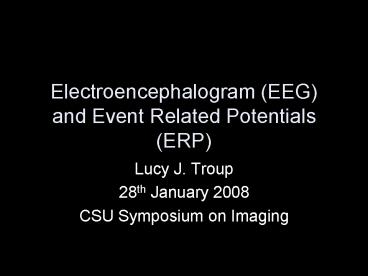Electroencephalogram (EEG) and Event Related Potentials (ERP) - PowerPoint PPT Presentation
1 / 27
Title:
Electroencephalogram (EEG) and Event Related Potentials (ERP)
Description:
Electroencephalogram (EEG) and Event Related Potentials (ERP) Lucy J. Troup ... Carly Yadon, MS Graduate Student in Psychology (Perceptual and Brain Science) ... – PowerPoint PPT presentation
Number of Views:1716
Avg rating:3.0/5.0
Title: Electroencephalogram (EEG) and Event Related Potentials (ERP)
1
Electroencephalogram (EEG) and Event Related
Potentials (ERP)
- Lucy J. Troup
- 28th January 2008
- CSU Symposium on Imaging
2
Electroencephalography (EEG)
- What is measured?
- electrical changes in groups of neurons
- How is it measured?
- Difference between two electrodes
- What types of changes can be measured?
- Sleep-related Certain neurological disorders
- How are these changes measured?
- Frequency, Amplitude, Specific Wave-Types
3
(No Transcript)
4
What are Event-Related Potentials?
- ERPs
- Electrical Potentials associated with specific
sensory, perceptual, cognitive, or motor events - From EEG to ERP
- Time-locked average of EEG from many trials
involving same event - Signal/Noise Ratio reduction what is left is
related to the event - EEG 20-50?v / ERP 1-10 ?v
5
(No Transcript)
6
- Time-locking Signal/Noise Ratio Reduction
- ERP derived from EEG
7
Where do potentials come from?
- Not action potentials
- ExcitatoryPostSynapticPotentials
- InhibitoryPostSynapticPotentials
- Most likely source
8
How do we analyze ERP waves?
- ERP Components
- Scalp-recorded neural activity that is generated
in a given neuroanatomical module when a specific
computational operation is performed - Peaks are not necessarily the same as components
peaks are not special - Peaks are comprised of summation of latent
components that are not observable, how we
analyze our ERP data will relate to the validity
and accuracy of our observations
9
Classic Approaches to Analysis
- Parametric Statistical comparisions
- Peak to Peak
- Mean Amplitude
- Peak Latency
- Covariation
- PCA
- Source Localization
- BESA
10
Well-studied ERP components
- Visual
- C1, P1, N1, N170
- Auditory
- BER, N1, MMN
- Cognitive
- N2b, N2pc, P3, N400, ERN, FRN, RP, LRP
11
(No Transcript)
12
ERP precautions
- Cant determine Where, only When
- Scalp Topography vs Source Analysis
- Doesnt measure all neural activity
- Closed vs Open Fields
- Can only use when time-locking is practical
- Not applicable for all areas of psychology
13
Some potential problems
- Artifacts
- Eye blinks, mm. mvt, etc.
- Lights, and other electrical sources
- Data Analysis Techniques
- Artifact detection rejection
- Filtering
- Reference electrodes (i.e. linked ears)
- Time-locking (stim or resp?)
- Segmenting (epochs, i.e. time windows)
14
What information does a component provide for
us?
- Example from Troup, Pitts, Draper Catellier
(2007)
15
Electrical Geodesics Inc. 128 channel high
density EEG
16
Experiment 1
- N19
- Raw and Gabor Faces
- Presented randomly
- 3 blocks of 66 faces
17
Experiment 2
- N19
- 7 Blocks 80 pairs per block
- Ss respond with key press to Same Face pairs
18
Questions
- Does N170 differ in amplitude and/or latency for
Gabor-filtered versus Raw face images? - Does N170 differ in amplitude and/or latency for
Gabor-filtered versus Raw for Scalp location? - Does N170 differ in amplitude and/or latency
under the manipulation of same/diff face pairs in
a rapid judgment task?
19
Scalp Location Frontal Left Temporal Right
Temporal Central Center Occipital
Behavioral Response Same Correct Different
Correct Same Incorrect
Stimulus type Raw Gabor
Amplitude and Latency
20
Same/Different Grand Average Data
21
Visual Sensory GatingTroup, Yadon, Pitts
Hafer-Zdral (2007/2008)
- Sensory Gating
- The process of gating out or not responding to
a subsequent stimulus after the onset of the
initial stimulus in rapid presentation - Auditory Stimuli clicks
- Visual Stimuli Flashes
- Term used interchangeably with Habituation
- Are they fundamentally distinct or same process?
- Do people behave to visual stimuli in same way as
auditory?
22
(No Transcript)
23
(No Transcript)
24
Stimulus Overlap
- Two differing Inter Stimulus Intervals (ISI)
Clearly show Stimulus overlap problems
25
(No Transcript)
26
Areas for Potential Collaboration
- The Stimulus overlap Problem
- ADJAR techniques
- Principal components analysis of ERP data
- Raw EEG and Spectral analysis
- Something I am hoping to look at in relation to
Gamma activity in the future
27
Thanks
- Colorado State University
- Dr Bruce Draper, Dr Ross Beveridge (Computer
Science) - Carly Yadon, MS Graduate Student in Psychology
(Perceptual and Brain Science) - Dan Lopez, MS Graduate Student in Psychology
(Perceptual and Brain Science) Erin
Catallier/Jessa Hafer-Zdral (REU Students) - Logan Keech (Undergraduate RA)
- University of California, San Diego
- Dr Mike Pitts (Hillyard Lab)































